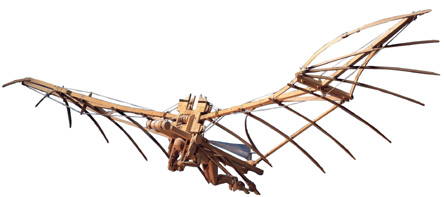For Leonardo, there could be no art without science. According to him, failure to realize this fundamental truth would result in painters being ranked as mere craftsmen. Not only did he insist that na artist should possess a sound knowledge of the laws of nature, but that he should also use scientific methods to reproduce three-dimensional images on two-dimensional surfaces. Then he could aspire to rival God himself as the Creator of nature in his paintings and sculptures.
As an engineer, Leonardo worked on the latest destructive weapons and defence systems of the day, content to take the money available for such work. He also pioneered work on accurate mapping techniques and devised canal projects and irrigation systems. He invented a wide variety of practical machinery, both for making tools and carrying out different tasks. Occasionally he wint well beyond the limit of contemporary scientific knowledge as, for example, when he tried to devise a flying machine. However, his botanical investigations into plant growth were sound, and centuries ahead of his time.
Leonardo endeavored to create a scientifically organized body of knowledge based on what was known in his day. His methods and concepts were essentially visual, and he did not make the disticntion between 'experience' and 'experiment' that scientists make today. He set out to fuse the ancient concepts of the macrocosm of the world with the microcosm of man, the latter reflecting the former. He accepted Plato's argument (4th century BC) that the world consisted of four elements (earth, water air and fire), with four powers (movement, weight, force and impact). These elements resulted in the four humours of man - earthly melancholia, airy sanguinity, fiery choleric and watery phlegmaticism.
In or around 1492, Leonardo wrote:
quote:
Man has been called by the ancients a lesser world, and certainly the award of this name is well deserved, because, in as much as man is composed of earth, water, air and fire, the body of the earth is similar; just as man has in himself bones, the supports and armature for his flesh, the world has the rocks, the supports of the earth; just as man has in himself the lake of the blood, in which the lungs increase and decrease while breathing, the body of the earth has its oceanic seas, which likewise increase and decrease every six hours with the breathing of the world; just as from the said lake veins originate, which proceed to ramify throughout the human body, the oceanic seas fill the body of the earth with infinite veins of water; the nerves are lacking in the body of the earth - they are not there because nerves are made for the purpose of movement, and the world, being perpetually immobile, does not need movement, and, not needing movement, the nerves are not necessary. But in all other respects they are very similar.
When he wrote on anatomy and geography, he drew on this analogy, using phrases such as 'the veins of water' and 'the breathing of this terrestrial machine'. The idea that the veins in the earth through which water flowed were similar to human blood circulation was as old as Seneca, and was still held by Leonardo's contemporaries. For Leonardo the subject lay at the very heart of his vision of life's principles. The universal laws of function and form which govern the world, the macrocosm, must also control man, the microcosm. Since this controle arose from 'necessity', the analogy of the relationship came within the realms of scientific investigation. His unique contribution was to present the analogy in such a visual way. His series of images of nature and man illustrate their shared vitality of form and motion; no other artist has portrayed this analogy so vividly. His drawings of the landscape, rocks and water demonstrate this superbly, and his painting of the pregnant Mona Lisa, seated before a background of active geological change, portrays the relationship to perfection. Leonardo saw painting as the supreme art, because it gave permanence to something that was essentially transitory - the very powers of Nature herself.
-pages 10-11 of "Leonardo, a Portrait of the Renaissance Man" by Roger Whiting
I find this fascinating on so many levels, and just wanted to share it with you all. Especially I am interested in the Platonic elements and correlation:
- Earth - weight - meloncholia
- Water - movement - phlegmaticism
- Fire - force - choleric
- Air - impact - sanguinity
Funny, I listed them in the order I know from chakra listings, bottom up, but the list is upside down eh?
And "permanence to something that was essentially transitory" is so interesting to me, well, a painting (heaven forbid) could be destroyed more easily than the landscape couldn't it? A recording of music makes it more permanent, but recordings can break.. and in some ways actual performance is better.. Though it is awesome how art "time capsules" things, storing them for later easy retrieval.. just some thoughts on permanentizing he he..
May our sharing of arts and sciences help make our selves better (microcosms), and our world better (macrocosm). Amen. And so it is.







